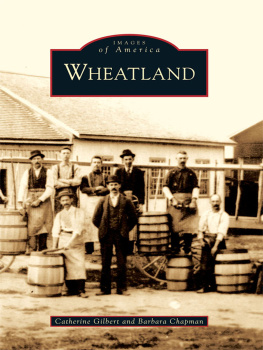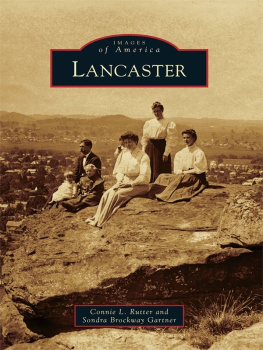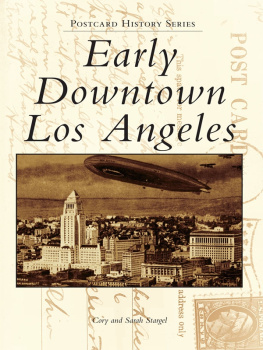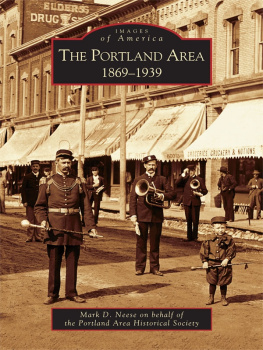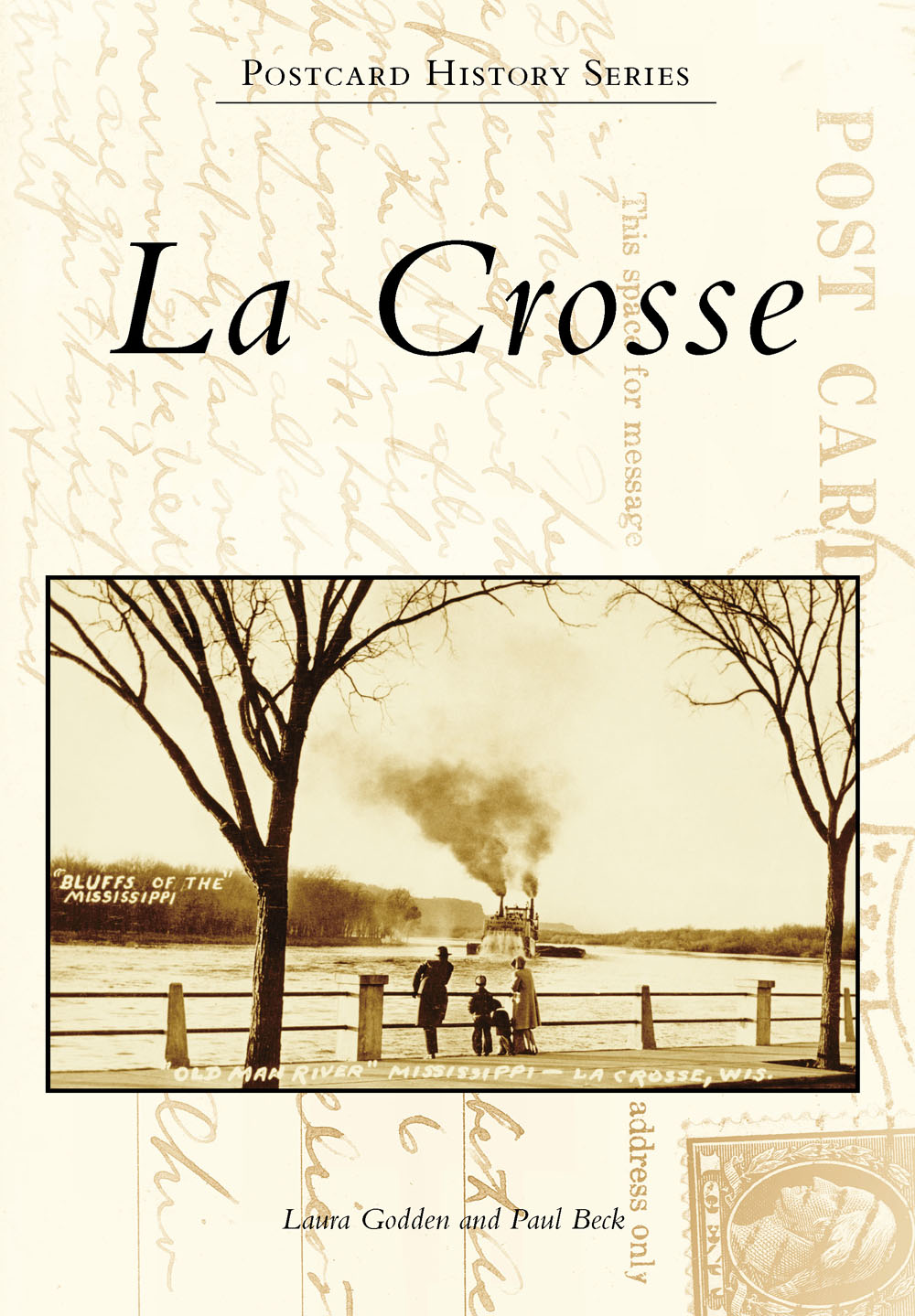
POSTCARD HISTORY SERIES
La Crosse

WATERFRONT FROM PETTIBONE PARK, 1907. Shown here is a reminder of how much society has changed in the last century. Mary informs the recipient, Marie Ostreng, that following their visit she safely arrived home, completing the 18-mile trip from Stoddard to La Crosse. Today, that distance seems almost inconsequential, and the same information can be instantaneously communicated via cellular telephone, social media, e-mail, or text. (Courtesy of Special Collections, Murphy Library, University of WisconsinLa Crosse.)
ON THE FRONT COVER: RIVERSIDE PARK. A family in Riverside Park watches the departure of the steamboat Alexander MacKenzie. This c. 1940 scene is not an uncommon sight today, as steamboats and families still routinely frequent the levee. The image is also reminiscent of a life-size bronze statue in the park of two children greeting steamboats, titled A Simpler Time. (Courtesy of Special Collections, Murphy Library, University of WisconsinLa Crosse.)
ON THE BACK COVER: MAIN STREET. This 1930s view of Main Street features brick-lined streets and trolley tracks in downtown La Crosse. Farther back, the steeple of the old St. Josephs Cathedral pierces the skyline. Several businesses of La Crosses past are visible, including Liggetts Drugstore, Kinney Shoes, and the Odin Oyen interior-decoration firm. (Courtesy of Special Collections, Murphy Library, University of WisconsinLa Crosse.)
POSTCARD HISTORY SERIES
La Crosse
Laura Godden and Paul Beck

Copyright 2015 by Laura Godden and Paul Beck
ISBN 978-1-4671-1332-8
Ebook ISBN 9781439649572
Published by Arcadia Publishing
Charleston, South Carolina
Library of Congress Control Number: 2014944889
For all general information contact Arcadia Publishing at:
Telephone 843-853-2070
Fax 843-853-0044
E-mail
For customer service and orders:
Toll-Free 1-888-313-2665
Visit us on the Internet at www.arcadiapublishing.com
To Murphy Library, the University of WisconsinLa Crosse, and all other institutions of learning and historic preservation
CONTENTS
ACKNOWLEDGMENTS
First and foremost, special appreciation goes to Edwin Hill, retired Special Collections librarian and La Crosse Area Research Center director, for his work in establishing a stellar local historybased collection in Special Collections, Murphy Library, University of WisconsinLa Crosse. Murphy Librarys postcard collection, the basis of this book, is undeniably a product of 50 years of Eds dedicated labor. He unselfishly continues his commitment to the collection. Even 16 years after his retirement, he regularly brings in materials to expand the collection.
Professor Emeritus Leslie Crockers research uncovering the history of La Crosses architecture has been especially helpful in the crafting of this work. Moreover, Dr. Crocker often generously invites the authors of this book along on his historical quests. His wonderfully informative book Places and Spaces: A Century of Public Buildings, Bridges, and Parks in La Crosse, Wisconsin beautifully presents his research and findings to the community. Dr. Crocker and his website www.lacrosse-buildings.com are invaluable resources for the authors.
The authors would like to thank the entire Murphy Library staff for their encouragement and support during the writing of this book. Laura would also like to thank her parents, Tim and Nancy Godden, for all of their help and kind words. Additionally, a huge thanks is owed to Dave Lange, Andrea Anderson, Jacob Davis, Teri Holford-Talpe, and Dani Weber for helping proofread the manuscript for this book.
Lastly, a shout-out and general thanks go to the dedicated student workers of Special Collections. They espouse a willingness to learn, assist researchers, and improve the collection. These students are responsible for both safeguarding and making the holdings accessible to the community. Their commitment, productivity, and contributions are essential to the operations of the unit.
All images in this book appear courtesy of Special Collections, Murphy Library, University of WisconsinLa Crosse.
INTRODUCTION
The city of La Crosse, in order to survive, grow, and retain relevancy as a regional economic and cultural center, has undergone several evolutionary transformations over its history. It has gone from a Native American gathering place to a fur trading post and then from a pioneer village to a boom-and-bust logging town. After that, it morphed from a manufacturing, commerce, and industrial center to its current state as a regional leader in health care services and higher education. This monograph attempts to investigate, explain, and visually represent the years surrounding the transitional period at the turn of the 20th century that most markedly shaped the community.
The first person of European ancestry to establish permanent residency in La Crosse was 19-year-old Nathan Myrick. In 1842, he built a log cabin trading post near the confluence of the La Crosse, Black, and Mississippi Rivers in what would later become downtown La Crosse. The location, due to the favorable river geography that facilitated transport, was already an assembly point for trade, socialization, and athletic gatherings by Ho-Chunk, Ojibwe, and Sioux tribes. Before Myricks arrival, French voyageurs had named the site Prairie La Crosse.
La Crosse maintained its trading post status until the early 1850s, when the population started to dramatically increase due to a growing commercialized sawmill industry dependent on tree reserves north of the city. Cut lumber was floated down the Black and Mississippi Rivers to the sawmills in La Crosse. By 1856, enough people lived in La Crosse to officially incorporate, and the Wisconsin State Senate chartered the city.
Two years later, the arrival of rail transport ushered in further economic growth and prosperity for the city, which was already an established steamboat port. Moreover, the new railroad connection transformed the social makeup and size of the citys population. New settlers included both established Americans from the eastern portion of the United States and European immigrants, many coming from Germany and Norway.
Arriving immigrants sought a higher standard of living, improved social status, and greater employment prospects. These desires included business and land ownership. Push factors for immigration in the 1860s included bad farming conditions in Norway and political and civic upheaval in Germany that sometimes resulted in forced conscription into the Prussian military. The influence of these immigrant groups on the city is clear, as La Crosse had German and Norwegian newspapers, churches, and social clubs. Later, in 1880, a wave of Bohemian immigrants joined the city. The State of Wisconsin promoted immigration to the area, distributing pamphlets and placing advertisements in newspapers in Western Europe.
The population boom of the late 1800s exacerbated the unceremonious displacement of the regions Native American inhabitants. Federal government policy initiated the removal of native peoples in 1836. Even though the governments major efforts subsided around 1880, fear and personal gain propelled settlers to encourage further displacement. The extraction of Native Americans from La Crosse is ironic, as Native Americans were the very people whom Nathan Myrick depended on for trade, which was the trade that spurred the establishment of the city in the first place. Additionally, the city is named after the Native American stickball sport that was often played at its location.
Next page


